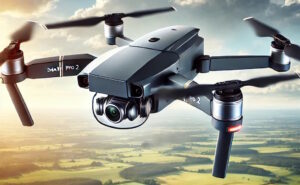Drone technology is revolutionizing community planning, making it faster, cheaper, and more accurate than ever before. Imagine having a device that can capture high-quality images, analyze the landscape from above, and monitor changes over time. Communities that need precise, thorough data about their land can now access all of this and much more thanks to drones. From coastline surveillance to graveyard security, drones are revolutionizing how communities make plans for the future. Let’s look into how.
Benefits of Drone Technology in Community Planning
Drones have changed everything when it comes to getting data for community projects. To begin, they are very exact, taking pictures and data that are clear and sharp even in tight spaces. Traditional ways of mapping can take weeks, but drones can get very detailed data in just a few hours. This saves time and money because it means fewer people, fewer tools, and a lot less time on the ground.
Drones also give a clear picture in real-time. A community’s people can immediately not see how their land is laid out and how their infrastructure is doing. With drones, they can get real-time information that helps them make quick choices. Drones also enable getting important information to Northern Ontario’s remote areas that need a big crew or heavy equipment.
Key Drone Applications in Community Mapping and Data Collection
Drones are great for many types of community projects, such as mapping the land to plan land use, evaluate infrastructure, and monitor the environment. You could be looking at a land-use plan that shows every house, tree, and waterway in great detail. Drones make this possible. They fly above the land and take pictures that give you a full picture that you can’t get from the ground. Drones can also zoom in on small features like cracks in roads or the health of bridges, which helps planners find problems before they become big.
Another big area is monitoring the environment. Drones can monitor plants, soil, and animal environments, helping people in a community learn more about their natural resources. This is a huge plus for towns in Northern Ontario that care about the environment.
Drones in Action: Gravesite Protection, Shoreline Mapping, and Flood Risk Assessment
Let’s dive into three specific examples where drones have made a real impact on community planning:
- Gravesite Protection and Mapping
Protecting burial sites is deeply important, especially for communities with sacred or historical gravesites. With drones, communities can locate and document gravesites accurately without disturbing the land. Imagine a bird’s-eye view of a site, with every grave marked and mapped so future generations know exactly where they are. By using drones, communities respect these sites while also preserving them. This approach ensures gravesites are protected and properly recorded, reducing the risk of unintentional disruption. - Shoreline Mapping and Erosion Tracking
For communities near lakes or rivers, shoreline erosion is a constant worry. Over time, erosion can damage property and even threaten homes and infrastructure. Drones make it possible to monitor shorelines regularly, creating a visual record of how the landscape changes month by month, year by year. Imagine having a map that shows today’s shoreline and traces back changes from the past. This tracking helps communities prepare for future risks, like deciding where to place protective barriers or develop new land. With drones, shoreline management becomes proactive, not reactive. - Flood Risk Assessment and Emergency Planning
Floods can be devastating, especially in Northern Ontario’s remote areas. By mapping areas at risk of flooding, drones help communities plan more effectively. A drone can fly over rivers, drainage areas, and low-lying land, spotting potential risks before heavy rains or snowmelt increase the threat. This kind of insight allows planners to design flood prevention systems, create evacuation routes, and identify safe areas. In this way, drones help build resilience against natural disasters, making communities safer and better prepared.
Building Local Knowledge and Capacity with Drone Technology
One of the coolest things about drone technology is that it could give people in small towns more power. Instead of hiring outside experts for every mapping or tracking project, communities can learn how to fly drones independently. Training programs teach many skills, from simple drone flying to complex data analysis. For this reason, communities can own drone technology over time and not just use it for their own good.
Imagine someone in your community who knows how to fly a drone and how to look at data and decide what to do based on what they see. With this kind of local knowledge, communities can plan and build themselves in the long run. It’s about giving people the skills and confidence they need to shape their own lives (skills and confidence building).
CES’s Commitment to Responsible Drone Usage
CES’s drone services bring powerful mapping and data collection to communities, making it easier to plan, protect, and develop land. Our drones create high-resolution visuals and 3D models that reveal your land’s full potential, helping guard against natural risks like flooding and erosion and support future growth.
The Drones and What They Do Best
- Perimeter 8: Built for precision, the Perimeter 8 uses advanced LiDAR to gather highly detailed data. It’s perfect for projects needing deep insights, like grave site identification, resource analysis, and forest planning. This drone can handle dense areas and flies up to 5 hours, covering over 1000 hectares in a day.
- eBee X: When it comes to large-scale mapping, eBee X is the go-to. Covering 400 acres per hour, it’s perfect for shoreline mapping, emergency planning, and site selection. It offers high accuracy with a light, agile design that’s efficient for vast areas.
- DJI Mavic Pro 2: For stunning videos and photography, the DJI Mavic Pro 2 is ideal. With a 12 MP camera and 30-minute flight time, it captures crisp visuals that bring your land to life.
CES drones make data collection easy, accurate, and tailored to your needs, giving your community the tools to shape its own future.
The Future of Community Planning with Drones
One of the most exciting things about drone technology is how it can empower people in small towns. Instead of relying on outside experts for every mapping or surveying project, community members can learn to operate drones themselves. With training programs that cover everything from basic flying skills to advanced data analysis, locals can become their own experts, building valuable skills over time.
Imagine someone in your town who not only knows how to pilot a drone but also understands how to interpret the data and make decisions based on it. This kind of local expertise can help communities take charge of their own planning and development. It’s about equipping people with the skills and confidence to shape the future of their own community.




0 Comments